Nature: MIT discovers new clues that distinguish the human brain
- Statins Lower Blood Lipids: How Long is a Course?
- Warning: Smartwatch Blood Sugar Measurement Deemed Dangerous
- Mifepristone: A Safe and Effective Abortion Option Amidst Controversy
- Asbestos Detected in Buildings Damaged in Ukraine: Analyzed by Japanese Company
- New Ocrevus Subcutaneous Injection Therapy Shows Promising Results in Multiple Sclerosis Treatmen
- Dutch Man Infected with COVID-19 for 613 Days Dies: Accumulating Over 50 Virus Mutations
Nature: MIT discovers new clues that distinguish the human brain
- Red Yeast Rice Scare Grips Japan: Over 114 Hospitalized and 5 Deaths
- Long COVID Brain Fog: Blood-Brain Barrier Damage and Persistent Inflammation
- FDA has mandated a top-level black box warning for all marketed CAR-T therapies
- Can people with high blood pressure eat peanuts?
- What is the difference between dopamine and dobutamine?
- How long can the patient live after heart stent surgery?
Nature: MIT discovers new clues that distinguish the human brain.
Are the brain circuits of humans and monkeys the same?
What makes people rich in emotion and self-awareness?
In medical experiments, can monkey brain or mouse brain replace human brain, can the same effect be achieved?
From daily happiness, anger, sorrow and joy to major life decisions, the destiny of mankind is closely related to this magical organ of the brain.
It is this unique, mysterious brain with an average weight of about 1.2-1.4 kg that distinguishes humans from other animals and establishes human civilization. According to neurologists, the human brain has as many as 100 billion neurons.
In traditional research, scientists have compared humans with other mammals mainly in terms of the size, weight, and structure of the brain, but they still can’t explain why humans’ cognitive abilities are different.
For example, in previous cognition, humans and elephants are both mammals, but why don’t elephants with more neurons evolve to be smarter?
Recently, a research team from the Massachusetts Institute of Technology (MIT) and its collaborators have given some clues to this series of questions.
Studies have shown that the biophysical properties of neurons in the human cerebral cortex do not conform to the general laws of other mammals. Compared with other mammals, the number of neuronal ion channels in the human cerebral cortex that allow calcium, potassium, and sodium plasma to flow is much smaller than expected.
The first author of the paper, Lou Beaulieu-Laroche, said: “Comparative studies have confirmed that although the structure of the human brain is the same as that of other mammals, human neurons are special.”
On November 10th, the related paper was published in the journal Nature with the title ” Allometric rules for mammalian cortical layer 5 neuron biophysics ” .
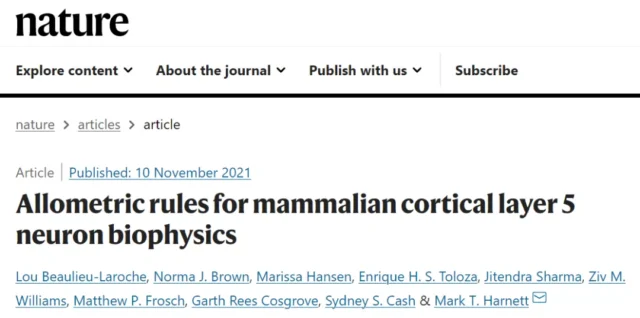
It is different from the mouse head and the mouse brain.
The research team’s experiment to compare the human brain with other mammals began in 2018, and their first object was a mouse.
They found that the human cerebral cortex pyramidal neurons dendrites fifth layer easily excited, and also than the mouse brain dendrites (dendrites) longer, a feature that has changed the human brain neuron cell body and dendrites input – output nature.
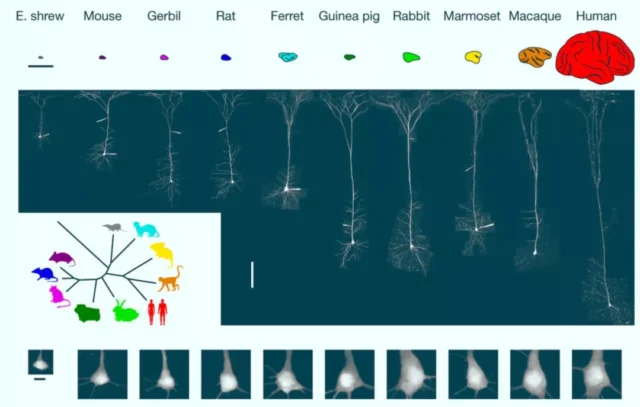
Figure | Comparison of the morphology of the fifth layer of pyramidal neurons between humans and 9 mammals (source: the paper)
The so-called dendrites refer to the multiple protruding tissues on neurons, so named because they are dendritic.
For the brain, dendrites are the key structure for transmitting information between neurons and within each neuron. It accepts an input neuron chemical signals, the excitation excitatory action potential upon reaching a critical point (Action potential) , and further transmission of information.
The cerebral cortex of primates is generally divided into six layers. The outermost layer, which is located under the skull, is the first layer, and the innermost layer, which is the sixth layer, closest to the white matter.
The fifth layer studied by the research team refers to the inner pyramidal cell layer, which contains large pyramidal neurons , which are the main excitatory neurons in the prefrontal cortex. Excitatory neurons can transmit information to neighboring cells, while inhibitory neurons are responsible for slowing down or blocking the firing behavior of excitatory neurons.
The research results of the research team in 2018 laid the foundation for further comparison of human cortical neurons.
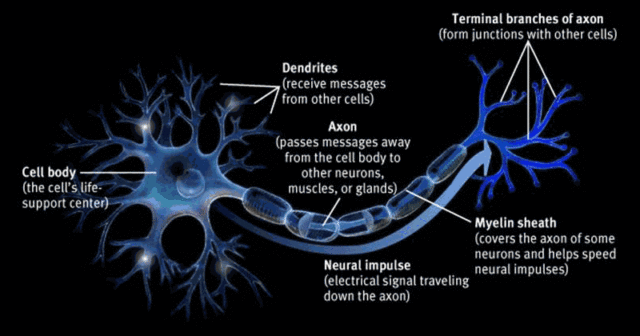 Figure|Schematic diagram of neuron signal transmission process (Source: UCLA)
Figure|Schematic diagram of neuron signal transmission process (Source: UCLA)
Compared with other mammals
It is not enough to find the difference between humans and mice in the fifth layer of pyramidal neurons.
In the latest study, the research team compared the fifth-layer pyramidal neurons of nine different mammals and humans, hoping to gain a more comprehensive understanding of the biophysical laws of mammalian neurons.
In this experiment, the 9 mammals that made outstanding contributions are: small smelly shrew (the smallest mammal) , gerbils, mice, rats, guinea pigs, ferrets, rabbits, marmosets and macaques. Human brain tissue is removed from epilepsy patients during brain surgery.
The study found that in these nine mammals, the density of neuronal ion channels increased with the increase of neuron size. For example, the size of neurons in the cerebellum of the little smelly shrew is very small, while a single neuron in the rabbit’s brain is much larger. Therefore, in the same volume of brain tissue, the number of neurons in the little stinky shrew is much more than that of the rabbit.
However, because of the higher density of ion channels in rabbit neurons, the number of ion channels in the two rodents should be roughly the same in the same volume of brain tissue.
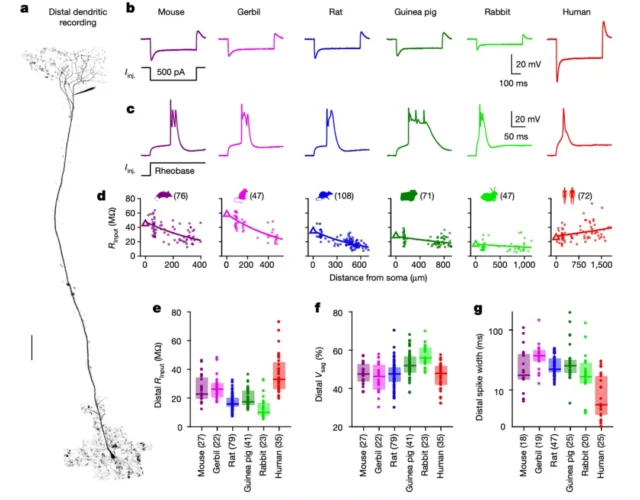 Figure|Comparison of input and output properties of dendrites (source: paper)
Figure|Comparison of input and output properties of dendrites (source: paper)
After analyzing a data set consisting of 2,250 patch clamp records, the researchers confirmed that this rule applies to the nine mammals in this experiment.
In other words, in the same species, the number of ion channels per unit volume in the fifth layer of the cerebral cortex is roughly the same, and the energy required is roughly the same. This phenomenon is called by neuroscientists the conserved conductance per unit brain volume.
However, the research team was surprised to find that the human brain tissue slices in the experiment did not conform to this rule, with the exception of the pyramidal neurons in the fifth layer of the human cerebral cortex.
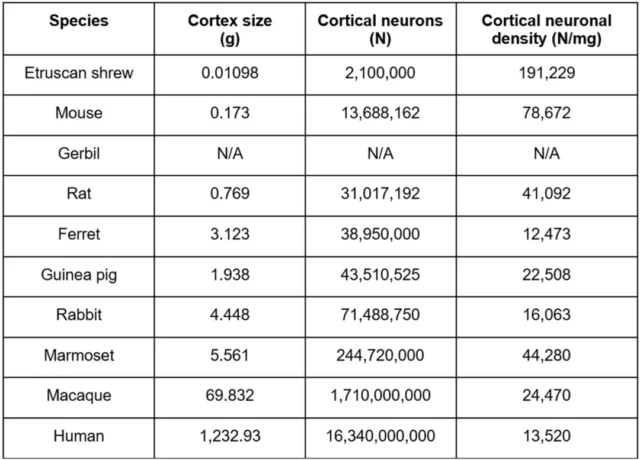 Figure|Mammalian cerebral cortex and neuron density number table (source: the paper)
Figure|Mammalian cerebral cortex and neuron density number table (source: the paper)
Generally speaking, ion channels have three important characteristics: conducting ions, identifying and selecting specific ions, and opening and closing according to specific electrical, mechanical or chemical signals.
Channels in nerves and muscles guide ions through cell membranes at extremely fast speeds, thereby providing a large amount of ionic current: as many as 100 million ions may pass through a channel every second.
Since ion channels are usually places where drugs, poisons or toxins act, they play a vital role in the physiology and pathophysiology of the nervous system.
Researchers believe that the decrease in ion channel density in the human brain may be the result of a trade-off during evolution .
In order to reduce energy consumption, the human brain reduces the number of ion channels, allowing the brain to use energy for other things, such as creating more complex synaptic connections between neurons, or firing action potentials at a higher rate.
Of course, this theory has yet to be confirmed. But some of the major issues raised by the latest findings are:
Is the human brain fundamentally different from other mammals?
Is it scientific to infer the mechanism of human psychology from the behavior of mammals?
Can pharmacological studies based on mice and macaques accurately reflect the operating mechanism of human brain neurons?
Getting to know the human brain has just begun
In fact, this is not the first study to challenge traditional neuron theory. In recent years, more and more studies have proved that the human brain and other mammals have different brain mechanisms.
In 2018, an international team led by the Allen Institute for Brain Science discovered a new type of human brain cells in the outermost layer of the cerebral cortex and called these new cells “rosehip neurons” .
The most amazing thing is that these cells only exist in the human brain and have never been found in the brains of other animals.
It is estimated that rosehip neurons account for 10-15% of the inhibitory neurons in the neocerebral cortex (Layer I) , and have a powerful inhibitory and regulatory effect on the excitatory input of the whole brain.
In addition, in 2019, researchers from the Weizmann Institute of Science in Israel (Weizmann Institute of Science) and other institutions also found that neurons in the human brain process information more efficiently, but the synchronization and stability of neurons in the monkey brain Sex is better.
According to research, in the case of encountering a tiger, the monkey needs the brain to always make an escape response steadily. For more advanced people, the brain can comprehensively analyze more information about the environment and make changes. Think more about the reaction.
Obviously, our understanding of the brain has just begun.
Although models such as mice have made great contributions to human psychology and neurology, the uniqueness of human cerebral cortex neurons still reflects the limitations of mammalian animal models.
Unlike other organs, the unique cognitive and emotional functions developed by the human brain have brought great challenges to scientists.
But it is precisely because of this uniqueness that we are born and differentiated.
References:
https://en.wikipedia.org/wiki/Human_brain
https://www.nature.com/articles/s41586-021-04072-3
https://www.sciencedaily.com/releases/2021/11/211110131613.htm
https://www.cell.com/cell/fulltext/S0092-8674(18)31106-1
https://zhuanlan.zhihu.com/p/93570240
https://www.nature.com/articles/s41593-018-0205-2
http://www.xinhuanet.com/science/2019-01/23/c_137764723.htm
Nature: MIT discovers new clues that distinguish the human brain
(source:internet, reference only)
Disclaimer of medicaltrend.org
Important Note: The information provided is for informational purposes only and should not be considered as medical advice.



